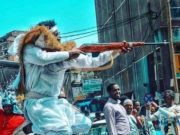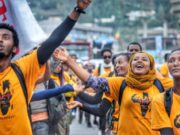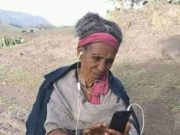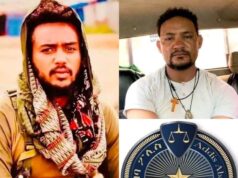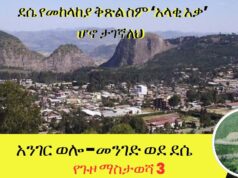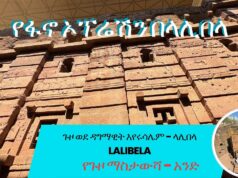“No heroes in Ethiopia today.”
Last week, on International Women’s Day, H.E. Prime Minister Dr. Abiy Ahmed made a stunning assertion: “Ethiopia has no heroes today.”
The fact that he made the bold statement before a gathering of women leaders was even more searing and ironically begged the question, “If Ethiopia does not have heroes, does that mean or imply Ethiopia has only heroines?”
His concluding remarks left no doubts in my mind that he sees Ethiopia’s destiny in the hands of its heroines.
Here is my translation of what he said (forward clip to 6:35-9:00):
Although Ethiopia has been called the land of jegnoch (home of heroes), today she has a massive shortage of heroes (jegnoch). In Ethiopia there are no heroes. Only mob (herd) followers. In Ethiopia, there are those who will engage in the usual customary practice of mudslinging (insults), the usual customary practice of killing, the usual customary practice of stealing and the usual customary practice of oppressing. But there are few who will oppose this mob mentality and declare it is an absolute shame to steal; it is an absolute shame to harm your brother; brother hating his brother is disgraceful. Ethiopia does not have heroes (jegnoch) who say it is a disgrace for the Tigrean to mistreat the Amharan, the Amharan to mistreat the Oromo, the Oromo to mistreat the one from Debub (South).
What Ethiopia has people who say, “Get ready. Arm yourself. Kill. These are people who inherit and repeat past mistakes. They cannot be called heroes (jegnoch). Real heroes are those who stand up amidst turmoil and conflict and bear the truth.
To fill this hero gap (deficit) as you celebrate March 8th, we should have heroines from Tigray go heroically to Bahr Dar and ask, “Is it not a disgrace for brother to kill brother?”. That is what is called the heroism of women. When heroes travel from Bahir Dar to Mekele, when heroes travel from to Jijiga and to Afar and challenge and stop the confused thinking, even though you may not have any cheer leaders to support you, and heroically confront them, then Ethiopia deserves to be called land (home) of jegnoch (heroes).
Following the mob (herd) does not a hero make. What makes a hero is standing for the truth. This task is appropriate for women because they are pillars, towers and givers. As you think of this day (Women’s Day), and so that others may remember their responsibilities and speak of their country’s honor and unity, I ask you with deep humility, as you continue with your work, to focus on peace and unity, love and reconciliation. (Applause)
The Greek word “hero” means “protector” or “defender”.
To the ancient Greeks, the hero was a mortal who performed a superhuman act which left an immortal memory elevating him to the status of the gods.
The “hero” in the Western tradition came to symbolize the vast possibilities human endeavors and achievements. Today, we regard those who stand for justice, equality and fairness as heroes. Those who sacrifice their lives for their country and put their lives at risk for the safety of others are also lionized as heroes.
In my view, anyone can become a hero so long as they perform heroic acts and deeds in the greater interest of the public good or humankind.
No heroes in Ethiopia…
Ouch, ouch, ouch…! Wechew gud!
PM Abiy’s statement stung some of us like a bee, and others like a wasp.
What did he really mean by his challenging and provocative assertion?
Right off the bat, my answer to PM Abiy’s assertion is that Ethiopia has heroes.
Just not the kind heroes and sheros is talking about.
I know of tens of thousands of heroes and sheros in every category.
They are called “ye dil atbiya jegnoch” (heroes and sheros who show up on the eve of victory and take credit for the battle won.)
I wrote about one group of ye dil atbiya jegnoch in December 2017 when I called for an
end to the deceptive intellectual culture of being a hero on the eve of victory (ye dil atbiya arbegna). The suffering Ethiopian people do not want fair-weather intellectuals who show up when the coast is clear, and the enemy has left the shores. They need intellectuals who are willing, able and ready to be the tip of the intellectual spear in fighting and defeating the ethnic apartheid T-TPLF regime today.
But what is an Ethiopian jegna (hero, shero)?
According to one author,
Jegna [hero] (Jegnoch, plural form) is an Amharic word describing those special people who have (1) been tested in struggle or battle (2) demonstrated extraordinary and unusual fearlessness, (3) shown determination and courage in protecting her/her peoples, land and culture, (4) shown diligence and dedication to our people, (5) produced an exceptionally high quality of work, and (6) have dedicated themselves to the protection, defense, nurturance and development of our young by advancing our people, place, and culture.
PM Abiy conception of a hero (jegna) appears to conform to the foregoing definition.
PM Abiy says a true hero does not kill his brother. A true hero is not a hater. A true hero stands on principle and has integrity. A true hero speaks the truth. A true hero brings people together, builds consensus and achieves reconciliation. A real hero works for peace, unity, love and reconciliation.
By these standards, I am afraid PM Abiy is right.
There are mighty, mighty few jegnoch in Ethiopia.
I can only imagine how much PM Abiy had to search for jegnoch in Ethiopia before making a statement that could ruffle the feathers of a few make-believe hero and sheros.
Perhaps he did a search like the ancient Greek philosopher Diogenes, who walked in a crowded market at high noon with a torchlight in hand looking to find an honest man.
Did PM Abiy have a Diogen-esque moment in Ethiopia looking for a jegna?
Did he scour the nine Ethiopian “kilils” (similar to apartheid Bantustans) and three chartered cities before he declared, “Ethiopia has no heroes”?
Did he set out to interview the leaders and members of the Oromo Democratic Party, Amhara Democratic Party, Tigray People’s Liberation Front, Southern Ethiopian People’s Democratic Party, Ethiopian Somali People’s Democratic Party, Arena Party, Oromo Liberation Front, Amhara Democratic Movement, Afar National Democratic, Harari People’s Democratic Party, Benishagul-Gumuz Democratic Party, Arbegnoch Ginbot 7 Movement…?
I do not know.
But PM Abiy is certain that unlike us today, the Ethiopia of our forefathers and foremothers had true heroes.
In search of… Where have all of Ethiopia’s heroes (jegnoch) gone?
If there are no heroes in Ethiopia today, then where have they all gone? Who has taken their place?
Are Ethiopia’s heroes dead and gone never to return?
Did they abandon the hero stage for Ethiopia’s sheros because they can’t handle the heat of being heros?
For years, I too have searched for Ethiopian heroes and sheros (jegnoch).
It was a futile search. “Could they be hiding, waiting just for the right moment to reveal themselves?”, I wondered from time to time.
My view on “heroes”, “sheros” and “heroism” is straightforward: Those who have favored positions in society have a moral obligation to perform heroic acts and serve the greater common good. To whom much is given, much is expected.
I believe the educated members of Ethiopian society are the tip of the spear in leading social change and coming up with new ideas to make things better. But where have Ethiopia’s intellectual heroes and sheros gone today and why are they silent as a church mouse?
I believe Ethiopia’s business wo/men and entrepreneurs have the obligation to lead Ethiopia into an era of prosperity. But where have Ethiopia’s business and entrepreneurial heroes and sheros gone today and why are they draining the country’s resources for self-aggrandizement?
I believe Ethiopia’s political leaders have a duty to work in common cause to bring peace, reconciliation and good governance. But where have Ethiopia’s political heroes sheros gone today and why are they not working with good will and in good faith to bring peace and reconciliation to a society riven by ethnic and sectarian antagonisms?
I believe Ethiopia’s faith and religious leaders should elevate the spiritual life of the nation by preaching, teaching and practicing truth, forgiveness and reconciliation. But where have Ethiopia’s faith heroes and sheros gone today and why are they not working day and night to bring reconciliation and harmony to a society beset by violence, hatred, distrust and animosity?
I believe Ethiopia’s journalists should be the eyes and ears of the society and provide accurate and factual information. But where have Ethiopia’s journalists heroes and sheros today and why are they not informing and elevating the public’s capacity to critically understand issues? Why are they fanning the flames of discord and strife? Why do they do tabloid journalism, spread fake news and disinformation?
I believe Ethiopia’s heroes and sheros in literature, music, art and sport command the cultural life of the nation. But where have Ethiopia’s cultural heroes and sheros gone today and why are they not working together to bring the diversity of traditions, customs and practices of the Ethiopian people to promote greater understanding and unity?
Ethiopia’s young people are indeed Ethiopia’s future of any country. But where have Ethiopia’s young heroes and sheros who suffered and died to bring about nonnviolent change gone today and why are they not working to chart a new future for their country?
Where have Ethiopia’s human rights defenders and activists gone? They protested and fought for nonviolent change and the rule of law for decades. Shouldn’t they be the vanguard in defending the nonviolent revolution they help bring about?
I don’t know where all of Ethiopia’s heroes gone!!
But I know what’s left behind!
Ethiopia’s heroes today are crybabies and villains
I like telling it like it is. I have done so all my life, but especially over the past 13 years.
I don’t mince words. I don’t beat around the bush.
I have made it a profession to speak truth to power, to the powerless and to those hungry and thirsty for power. My website proclaims, “Defend Human Rights, Speak Truth to Power”.
I know some people will not be able to handle the truth I am about to tell!
The truth is in place of heroes and sheros, today we have crybabies and villains in Ethiopia.
The truth is we have crybabies and villains who thrive in a culture of victimhood.
The truth is we have crybabies and villains who specialize in finger-pointing, bellyaching, teeth-gnashing and heart-aching.
The truth is we have crybabies and villains who thrive on accusation and recrimination and self absolution.
The truth is we have crybabies and villains who like to complain and whine about how they have been victimized and woe is them.
The truth is we have crybabies and villains who speak with forked tongue, and in doublespeak and doublethink.
The truth is we have crybabies and villains who spread fatalism (it will never work) and defeatism (accept defeat without struggle) among the population.
The truth is we have crybabies and villains who are hungry and thirst for power and could not care less what happens to the suffering population. 
The truth is we have crybabies and villains who would keep silent when millions are displaced but will make noise when displacement suits their narrow political ambitions.
The truth is we have crybabies and villains who think freedom comes without responsibility and therefore speak of wars and spread rumors of wars.
The truth is we have crybabies and villains who are so clueless they are incapable of coming up with any creative ideas of their own.
The truth is we have crybabies and villains who expect others to make sacrifices for them so that they can enjoy the benefits.
The truth is we have crybabies and villains who want others to do the heavy lifting so that they can take credit.
The truth is we have crybabies and villains who are fair weather friends. They will vanish like the morning dew at the sign of the first challenge.
The truth is we have crybabies and villains who…
Ahhh! How Ethiopia needs true heroes and she has only one!
Every culture and society has a hero in its own image.
Back in my undergraduate days many moons ago, I read Prof. Joseph Campbell’s 1949 book, “The Hero with a Thousand Faces”. Prof. Campbell is one of my personal heroes.
Having surveyed myths and traditions of heroism in many cultures, Prof. Campbell sought to create a universal profile of the “hero”.
Prof. Campbell concluded that in most cultures a hero/heroine does not fall from the sky but becomes one after going on a “journey”. That journey takes the hero/heroine from the ordinary world into a supernatural adventure where the hero/heroine faces extreme hardship, perils and challenges and eventually emerges victorious. The hero/heroine finally returns to mankind to bestow his boon.
There is much those who want to be Ethiopian heroes and sheros can learn from Campbell’s “monomyth” (hero’s journey).
To become a hero, one must take a long day’s journey into the night of the unknown, the unfamiliar and the perilous. The hero must be prepared to stand alone and apart from the herd, not fear condemnation or seek praise. “It is easy to stand with the crowd. It takes courage to stand alone.”
Campbell points out that coming through such struggles enables the hero/shero to develop a vision of greatness and a life of courage and fortitude.
Heroes and Zeroes
In June 2009, I wrote a commentary entitled, “Hero v. Zero”.
It was a defense of my shero Birtukan Midekssa.
The analysis focused on the doublethink, doublespeak, zerothink, zerospeak and the zero sum games of the late leader of the former regime in Ethiopia.
I concluded, “Truth be told, even in a zero sum game, zero plus zeros equal to zero, not hero!”
All of the crybabies and villains will not amount to a single hero.
But truth be told there is one true hero in Ethiopia.
In less than a year, that hero has emptied Ethiopia’s prisons of all political prisoners.
He ushered in an era of unfettered democratic freedoms.
He invited opposition political parties and urged to come together and help transform Ethiopia into a multiparty democracy.
He brought peace and stability in the Horn region.
He brought peace and reconciliation among faith leaders.
He secured the release of prisoners in the Middle East.
I could go on and on.
But the Financial Times, a British newspaper founded in 1888, best described our Ethiopian hero:
Abi Ahmed has overseen the swiftest political liberalisation in Ethiopia’s more than 2,000-year history.
That is the hero all of us wannabe heroes, sheros, imposters, crybabies and villains should emulate and support!
The Praxis of Medemer in the Horn of Africa
 Praxis is simply the practical application of theory.
Praxis is simply the practical application of theory.
In praxis, one is not interested in trying to understand the world in the abstract but to act in the world in order to change it and make it better.
Last week, H.E. Prime Minister Dr. Abiy Ahmed was doing whirlwind shuttle diplomacy demonstrating the praxis of his Medemer “theory” to the distressing, tragic and often aggravating politics of the Horn of Africa.
On March 1, PM Abiy hosted President Uhuru Kenyatta, who brought with him as many as 100 Kenyan government authorities, corporate and business community representatives, to discuss a range of economic and investment issues.
On March 3, PM Abiy and President Uhuru flew to Asmara to meet President Isaias for trilateral discussions on regional economic integration.
On March 4, PM Abiy and President Isaias were in Juba, South Sudan to discuss “regional peace, economic ties and infrastructure development”.
On March 5, Somali president Mohamed Abdullahi Mohamed “Farmajo” arrived in Ethiopia for bilateral talks.
On March 6, PM Abiy was in Nairobi mediating a maritime border issue on the Indian Ocean between Kenya and Somalia.
All I have to say is, “Henry Kissinger, king of shuttle diplomacy, eat your heart out!”
I have previously discussed in detail what “Medemer” means to me and its practical implications.
Broadly stated, “Medemer” consists of specific political practices to determine the collective destiny of a given people.
Dr. Martin Luther King, Jr. often said, “We must all learn to live together as brothers or we will all perish together as fools.”
“Medemer”, to me, is the road map out of the wilderness of the Valley of Fools in the Horn of Africa where we have lived for centuries as enemies hellbent on destroying each other.
PM Abiy’s Medemer in the Horn of Africa has a clear and unmistakable message and resonates the truth of MLK’s words:
We have great issues facing us today in the Horn of Africa. No individual can live alone; no nation can live alone. We are tied together in the Horn of Africa in a single garment of destiny, caught in an inescapable network of mutuality. And whatever affects one Horn country directly affects all indirectly.
The Horn of Africa today faces myriad issues ranging from grinding poverty, disease and ignorance to large scale population displacements (and population explosion) and endless strings of deadly conflicts.
What happens in each Horn country affects the others. War in one country threatens the peace in the other. Peace and democracy in one country becomes an example of good governance for others.
But for decades, Horn countries (Ethiopia, Eritrea, Somalia, Kenya, Djbouti, South Sudan and Uganda) have chosen the path of perishing as fools.
Ethiopia and Eritrea fought a needless war in the name of “national pride” and “territorial integrity” between 1998-2000, which resulted in the deaths of as many as 100,000 people, displacement of up to one million and diversion of much needed resources to buy bullets instead of butter.
In July 2016, a “general” of the now defunct regime in Ethiopia openly advocated waging war against Eritrea for the purpose of regime change.
Not long ago, Sudan built up its troop presence on its eastern border with Eritrea on the pretext of potential conflict in the Red Sea.
Over the past several decades, Ethiopia and Somalia have had three full blown wars and numerous border clashes in which untold numbers of civilians were killed and displaced.
Somalia and Kenya have had low intensity conflict for decades. Last month, Kenya broke diplomatic relations with Somalia over off-shore gas and oil disputes.
There have been recent tensions between Eritrea and Djbouti.
And history continues to repeat itself in the Horn endlessly.
Since the creation of South Sudan in July 2011, President Salva Kiir and former Vice President Riek Machar have manifestly decided not to live as brothers but perish as fools.
In 2013, a power struggle between President Kiir and Mr. Machar turned into armed conflict as Kiir accused Machar of plotting a coup.
The two leaders mobilized their ethnic bases and South Sudan was headed to hell in a handbasket. Thousands died and thousands more were displaced.
A peace agreement was reached in 2015 but it did not last as conflict flared in July 2016 and Machar was forced to flee the country. South Sudan was again in the grips of civil strife and the suffering of the people continued.
In September 2018, Kiir and Machar signed a 128-page peace agreement with the aim of creating a “revitalized transitional government of national unity” and conduct new elections, among other things.
When Machar returned to South Sudan in November 2018, Kiir said he had forgiven Machar and was ready to start fresh. “I want to reiterate that the war in South Sudan has come to an end. To forgive is not an act of cowardice. It is a Christian obligation.”
There is no guarantee the tenuous peace between Kiir and Machar will hold. Thus, the peacemaking mission of PM Abiy and President Isaias.
Medemer or “the need to advance the cause of regional integration”
PM Abiy and President Isaias received a warm reception in Juba.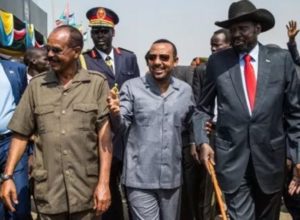
Regional integration is another phrase for “Medemer”.
PM Abiy’s office announced discussions with President Kiir will focus on “regional peace, economic ties and infrastructure development. In addition they will also be addressing issues of developing joint capacities and working together in an integrated manner.”
South Sudan’s foreign affairs minister Nhial Deng Nhial acknowledged the constructive role of the Ethiopian and Eritrean leaders and assured his government is “committed to pushing for the smooth implementation of the peace agreement.”
In a Joint Statement, the three leaders declared their discussions “focused on the need to advance the cause of regional integration” and “agreed to work out the common projects that will facilitate the attainment o of the goal of Regional Economic integration and shared prosperity.
I read the Joint Statement to mean the following:
The root and true cause of the political crises in South Sudan is not ethnic conflict or individual power struggle. The root cause is poverty. Poverty is an enemy no single country in the Horn can defeat on its own. There must be concerted effort by the countries in the region to uplift their people from poverty. In order to replace poverty with prosperity, there must be peace in each country in the Horn. Peace breeds prosperity; poverty breeds war.
Could South Sudanese faction leaders learn from PM Abiy and President Isaias?
In my view, the people of Ethiopia and Eritrea have never been enemies.
Neither do I believe the ordinary Dinkas and Nuers in South Sudan are enemies.
The problem of conflict is with the leaders and not the ordinary people.
I offer a simple thought experiment: If the people of Ethiopia and Eritrea were enemies, how can anyone explain the profusion of love, brotherhood and sisterhood we saw in Asmara and Addis Ababa when peace was declared and the two leaders visited each other’s capital?
Leaders may have differences and march their armies into war, but the people are never given a choice to decline peace and wage war.
For the past two decades, the drumbeat by the regime in Ethiopia was that Eritrea is the enemy. The Eritrean government responded in kind.
Both countries deployed troops on their borders pointing and occasionally firing their guns on each other’s position. For two decades, the leaders of the two countries conducted a war of words.
All that changed when PM Abiy took office in April 2018 and announced to the House of People’s Representatives that he will seek peace with Eritrea and finally settle the border issue as decided by international arbitration. That resulted in PM Abiy’s historic trip to Eritrea in July 2018, which was followed by President Isaias’ historic trip to Addis Ababa.
When the border crossings between Ethiopia and Eritrea were opened on September 11, 2018, I was present as a witness to history.
When I visited Ethiopia after 48 years, the last thing I expected was to be present in person at the border when Ethiopia and Eritrea opened their borders for the first time in two decades and let the dammed love flow once again.
It was a prophetic moment.
By opening their borders, the two leaders made a commitment in full view of the world that they shall hereafter “beat their swords into plowshares, and their spears into pruning hooks: nation shall not lift up sword against nation, neither shall they learn war anymore.”
I hope to write about that intense moment when I became a witness to history someday. It was one of the defining moments in my life.
I was present in Bure, a forbidding desert where some of the fiercest battles took place during the Ethio-Eritrean war. As I stood looking over the barren moonscape, I tried to imagine the thousands who lost their lives.
And for what? How true the saying, “War is hell!”
I was present in Zalambessa, once a bustling border town reduced to a heap of rubble during the war.
I wondered if the wounded hearts of the survivors of Zalambessa would begin to heal now that they are allowed to have peace in a no war, no peace zone for the first time in 20 years.
I witnessed Eritreans and Ethiopians welcoming each other at the borders with tears of joy and ululation. I am confidently optimistic the best days of Ethiopia and Eritrea are yet to come.
The million dollar question is whether South Sudanese factions can learn from the peace and reconciliation process between Ethiopia and Eritrea and get their house in order.
Frankly, is there anyone better than PM Abiy and President Isaias to teach, preach and demonstrate in practice that it is perfectly possible to have peace and reconciliation among “enemies”?
The lesson for the South Sudanese leaders may lie in replicating the techniques and following in the footsteps and roadmap of PM Abiy and President Isaias.
How did PM Abiy and President Isaias manage to tear down the wall that had separated them for decades and build a bridge in just a few weeks that brought them together?
I am sure the two leaders will one day tell us how they did the impossible.
But in my speculative view, the two leaders were able to tear down the wall on their borders and replace it with bridges because they:
Took joint and full responsibility for the mistakes of the past without pointing fingers at each other. That is why we did not hear words of recrimination and accusation about who is more culpable than the other. They both owned up to the mistakes of the past.
Decided to look at the future if their countries through the lens of peace and reconciliation rather that their old dark glasses of war.
Came to an existential realization that their peoples are inescapably connected by birth, marriage, religion, culture and language and are bound in a single garment of destiny.
Shared a common vision for the future of their two countries and decided to overcome the burden of the past by embracing a new future of interdependence.
Were willing to take a chance for peace and avoid risking war.
Understood they are not enemies of each other, but face three deadly common enemies named poverty, disease and ignorance. Every day they fight with each other, they assure total victory for their deadly enemies.
Realized economic integration and interdependence are the only options for then to have a better and prosperous future. Peace and prosperity go hand in hand. Conflict, war and poverty will only result in misery.
Realized trust, good will, patience, integrity, giving each other the benefit of the doubt, avoiding tit-for-tat retaliation, keeping the channels of communication open are decisive in peace-building.
Understood Mandela’s maxim, “If you want to make peace with your enemy, you have to work with your enemy. Then he becomes your partner.”
Understood their people desperately need butter not bullets!
The future of Africa hangs in balance on the Horn
I hear some empty barrels criticizing PM Abiy for not “staying home and solve problems instead of trying to help neighbors solve their problems.”
I pity these benighted cry babies who cannot see beyond their noses.
These bellyachers fail to understand that not only the future of Ethiopia but the future of Africa hangs in the balance in the Horn.
As goes the Horn of Africa, so goes the rest of Africa.
The Horn is the laboratory, the proving grounds, for all of Africa. Will there be endless wars and conflicts that will bury the continent in the abyss of poverty? Are we on the cusp of a new era of collective prosperity and progress that will ensure Africa’s rightful place on the international stage?
If the Horn countries are able to come together (Medemer), make peace and build the foundation for peaceful and prosperous relations, the rest of Africa will follow in their footsteps.
The September 2018 South Sudan agreement is essentially about peace and reconciliation. Chapter V of that agreement talks about transitional justice, accountability, reconciliation and healing.
The people of South Sudan are not enemies of each other. If given a ghost of a chance, they would choose to live as brothers and decline their leaders’ offer to perish as fools.
The ordinary people of South Sudan are wise but they suffer greatly because of the foolishness of their leaders.
I am touched and share fully President Kiir’s statement that, “To forgive is not an act of cowardice. It is a Christian obligation.”
My personal view is forgiveness is the ultimate demonstration of human courage. That is the only way in and out of Africa!
Given the history of failure of ceasefires, agreements and understandings in the past, one could easily fall prey to pessimism and expect the worse.
There are threats that if Machar fails to join the reconciliation process, he may lose his status as official opposition leader.
I am not discouraged by political rhetoric. With a little help from their friends and neighbors, South Sudan will experience peace soon. Hope springs eternal!
My African brother’s and sister’s keeper: “Medemer”, all for one and one for all
I commend PM Abiy and President Isaias for travelling to Juba to keep the flames of peace flickering, if not blazing.
In my view, the two leaders are teaching by example (praxis). They came together (Medemer) and made peace.
Now, they are demonstrating to the world that together they are their African brothers’ and sisters’ keeper. They do not want the people of South Sudan to go through the pain and suffering of their peoples over the past 20 years.
That touches my heart.
For me, compassion is the greatest of all virtues.
But it is all counter-intuitive.
What PM Abiy and President Isaias seem to be saying is that South Sudan cannot have peace and prosperity unless the whole Horn region has peace and prosperity.
It is a hard concept to grasp.
It is like saying a family in a given neighborhood can neither have peace nor prosperity if the neighborhood is constantly beset by violence, conflict and strife.
So, the destinies of the Horn countries are intertwined.
For there to be lasting and durable peace, there must be vital economic ties and interdependence between Horn countries.
In the Horn of Africa, the rule is united we stand divided we fall and perish like fools.
When the people of the Horn have jobs, quality education for their children, affordable health care for their families, they will have no reason to engage in ethnic, religious and regional conflicts.
Therein lies the simple secret of “Medemer”: All for one and one for all.
All Horn countries for South Sudan and South Sudan for all countries in the Horn because the Horn of Africa is bound in a single garment of destiny.
I have a dream that one day the Horn of Africa will be a Horn of Plenty. 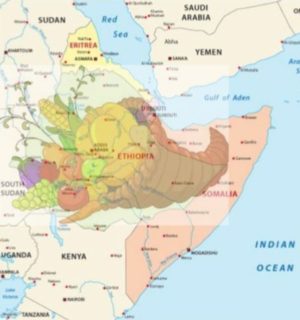
That is plenty of peace.
Plenty of love.
Plenty of respect, appreciation and gratitude.
Plenty of forgiveness and reconciliation.
Plenty of food and clean drinkable water.
Plenty of jobs and opportunities.
Plenty of hospitals, clinic and doctors.
Plenty of modern technology.
Plenty of good will.
Plenty of good leaders.
Plenty of…
Medemer: All for one and one for all in the Horn of Africa!
(to be continued…)
EXTRA! EXTRA! Read All About the TPLF’s Latest Strategy to Return to Power and Restore Ethnic Apartheid in Ethiopia

The jackal in sheep’s clothing is back!
The latest strategy by the bosses of the Tigrean People’s Liberation Front (TPLF) hunkered and bunkered down at the Axum Hotel in Mekele is to bring together elements of the Arena Party, Amhara National Movement and Oromo Liberation Front to wage a scorched earth opposition against the nonviolent change that is taking place in Ethiopia today and take over power.
The information supporting this revelation could have been related to me by member(s) of Arena Party, Amhara National Movement and Oromo Liberation Front or all three.
But there is no question that I have received the tip from a highly reliable informant(s).
The singular aim of the TPLF bosses in bringing elements of the three entities is to create a fake Amhara-Tigray-Oromo coalition behind which they can hide as they wage a scorched earth strategy to destroy what has been described as the Oromo-Amhara alliance, which resulted in the TPLF’s ouster.
The timing of the formation of the fake coalition is in itself curious.
In just about four weeks, PM Abiy will be celebrating his first year in office.
What better way to steal his thunder?!!
What better way to rain on his parade by parading a fakeAmhara-Tigray-Oromo coalition?!!
According to my source(s), the TPLF bosses recently concluded a secret assessment of their efforts to date to destabilize and usher in a period of chaos in Ethiopia.
The conclusions they reached are self-evident and plain for all to see.
Their attempts at taking the life of PM Abiy Ahmed have failed.
Their attempts to instigate a coup have failed.
Their attempts to create ethnic tensions which could deteriorate into ethnic and religious civil war in various parts of the country have failed.
Their attempts to create division and strife within the EPRDF have failed.
Their attempt to scare monger the population about an imminent genocide have failed.
Their attempts to mobilize international support for themselves by claiming genocide and ethnic persecution have failed.
They have failed on all fronts. The TPLF is confused and bewildered about what to do to get back in the game.
What can the TPLF bosses do in the face of the total failure of their political intrigue and machinations?
The TPLF bosses have decided to return to their tried and tested dirty old tricks of divide and rule.
For the last 27 years, the TPLF maintained its ethnic apartheid system in Ethiopia by pitting Oromo against Amhara, Tigray against Amhara, Sidama against Wolieta, Afari against Somalia and so on.
But the TPLF’s ethnic apartheid system came apart almost a year ago when H.E. Dr. Abiy Ahmed became prime minister.
Over the past year, the TPLF bosses have left no stone unturned to demonize, criticize and ostracize PM Abiy and his administration.
They have waged scurrilous attacks on the integrity and reputations of the leaders of the nonviolent Ethiopian revolution.
Above all, they have done everything in their power by using billions they have stolen they have stolen from the Ethiopian people to
1) trivialize the achievements of the PM Abiy administration;
2) delegitimize the extraordinary and historic democratic changes in Ethiopia by waging a concerted and coordinated cyber psychological warfare on social media; and
3) direct and coordinate behind the scenes death and destruction they hoped will bring Ethiopia into civil war.
To accomplish this purpose, they have not only paid street thugs to wreak havoc on the civilian population in the countryside but also hired empty barrel intellectuals, journalists, pundits and trolls to wage psychological cyber warfare for them.
But their efforts have only produced strange fruits of death and destruction.
Their message of hate and division has fallen on deaf ears.
But they continue to preach their gospel of ethnic supremacy to their chorus of hate mongers and thugs.
But the Financial Times, a British newspaper founded in 1888, best described the changes that have taken place in Ethiopia over the past year in its report a few days ago. Abi Ahmed
has overseen the swiftest political liberalisation in Ethiopia’s more than 2,000-year history.
The TPLF bosses today are hellbent on totally destroying the current reform and liberalization process in Ethiopia at any and all costs.
What must the TPLF bosses do to destroy Ethiopia’s nonviolent revolution?
That in a nutshell was the quintessential question the TPLF bosses faced at the end of their analysis (gimgema) recently.
The consensus they reached was unambiguous:
Destroy once and for all the so-called Oromo-Amhara alliance which ended the TPLF’s ethnic supremacy and ethnic apartheid in Ethiopia.
TPLF boss Getachew Reda once said of Oromos and Amharas coming together, “If Amharas and Oromos are united, that means we, the TPLF, have not done our homework”.
Getachew Reda also said, “Amhara and Oromo are like “chid” (the chaff from Ethiopia’s staple food teff) and fire (the equivalent of fire and highly combustible pampas grass). They can never come together as one.”
I know exactly what the TPLF bosses think of Amharas. I have it documented it over the years.
The TPLF bosses believe Amharas are “retards” and “enemies”.
This is also exactly what they tell and teach their children about Amharas:
Yes, the Gojames (Amara people) are called retards. Gonderes (another Amhara people) are enemies. They should not be given awards. They are retards. In terms of thinking, their brains, they are low, very low. They are low retards. They are in a separate category. They represent a retarded idea, a retarded way of doing things.
The TPLF bosses believe Amharas are dumb as a flock of turkeys.
The TPLF also believes Amharas must be wiped out as an ethnic group.
It is all in their Manifesto and corroborated in the testimony of their top leaders.
I also know exactly what the TPLF bosses think of Oromos.
They believe Oromos are “criminals and terrorists”.
They believe Oromos do not have the innate ability to govern or exercise political power because they too are dumb and stupid.
The ignorant TPLF thugs are clueless that Oromos are the originators of the African Gada democratic system!
The TPLF bosses believe they, and only they are the smartest, the brightest, the bravest and the chosen ones.
The rest of Ethiopians are God-forsaken fools and idiots, as their late leader used to say.
well, the TPLF bosses are now back to school, the school of intrigue, double-dealing, conspiracy and monkey business.
They are huddled to do their homework.
What is their homework today? Well, it is the homework they did not finish yesterday!
Slice, dice, mince, divide and chop Ethiopians into hate groups so that they can cannibalize each other while the TPLF bosses sit at Hotel Axum sipping French cognac.
The TPLF bosses have done their homework.
They have created a make-believe, shell opposition force composed of elements of Arena Party, Amhara National Movement and the Oromo Liberation Front to do the dirty work for them by promising to
1) defend the constitution;
2) preserve ethnic federalism;
3) reject neoliberalism and oppose privatization of inefficient state-owned enterprises promised by PM Abiy;
4) give greater autonomy to local areas;
5) return Addis Ababa (Finfine) to Oromos;
6) rescind the Ethiopian-Eritrean peace accords by insisting on reclamation of Eritrean ports, among others.
The die has been cast according to the information I have received.
Elements of Arena, Amhara National Movement and the Oromo Liberation Front are in negotiations as of this writing and may be ready to announce their new coalition at any time.
The shadow coalition and fake shell opposition force the TPLF has created to undermine the current peaceful change may succeed in creating the illusion of a real opposition force and sow temporary confusion in a segment of the public mind, but it will not succeed.
There are three reasons why it will not succeed.
First, the Ethiopian people will not be fooled by the TPLF wolf in sheep’s clothing trying to sell them snake oil.
The TPLF bosses have always believed the people of Ethiopia are fools and idiots, as their late leader once said. They think they can hoodwink and bamboozle them with sweet talk and empty promises. But that too will fail.
Today, Ethiopia enjoys a free press with energetic journalists and bloggers who will shed the light of truth on the secret intrigues and machinations of the TPLF to return to power regardless of the tricks they may pull out of their rear ends.
Second, the TPLF’s ethnic apartheid system and ethnic supremacy is dead, dead, dead! It will never return to Ethiopia.
No amount of backroom dealing, payoffs of so-called opposition leaders, or armies of social media trolls and empty barrel intellectual, journalists and pundits will bring back to life the TPLF’s ethnic apartheid system.
Third, as I have warned the TPLF on numerous occasions, IT IS GAME OVER!
In October 2017, I wrote a commentary entitled, “Ethiopia: The Day After… the Firestorm”, I predicted the strategy the TPLF is using today.
I also predicted the TPLF’s endgame will be: “ ‘Apres nous, le deluge.’ After us, the flood.
Like the proverbial Ethiopian donkey which said, ‘After I am gone, I could not care less, if grass grows.”
After the TPLF is gone, they could not care less if grass grows in Ethiopia or Ethiopia is consumed in a forest fire.”
If Ethiopia cannot be a plaything and playground for the TPLF, she can go to hell in a handbasket.
But we Ethiopians care about our country.
We will make our country a paradise in Africa.
A year ago, Ethiopia rose from the hellfire of TPLF rule because God lifted her up by her outstretched hands.
I will prophesy to the TPLF bosses this simple truth. In the end, your swords will pierce your own hearts and your bows will be broken. If they doubt me, I challenge them to go back and review all of the prophesies I have made about them.
In February 2013, I prophesied the TPLF shall inherit the wind.
In February 2019, the TPLF inherited the wind.
In February 2019, the TPLF is gone with the wind!
I give one advice to my fellow Ethiopian sisters and brothers everywhere.
The price of liberty is eternal vigilance. Stay alert and awake.
The TPLF wolf in sheepskin is in your midst. Beware or the wiley wolf will get you by the jugular.
I call on all Ethiopians to stand vigilant and defend the nonviolent revolution on the ground and in cyberspace as the TPLF bosses roll out their latest and greatest show to reinvent themselves, return to power and reestablish ethnic apartheid!
What should we make of the three-ring dog and pony circus of the TPLF-created coalition composed of elements of Arena Party, Amhara National Movement and the Oromo Liberation Front?
Do what everyone does at any circus: Be entertained!
But never, never, never underestimate the wolf in sheep’s clothing.
Well, you read all about it here, first.








